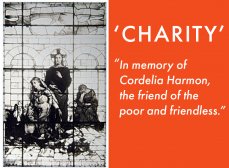
- Parish news
From the Historian: The Window 'Charity'
Dear Trinity Church and friends,
The window 'Charity' was designed by artist Frederic Crowninshield. It was located on the south wall in the Trinity Chapel, an area now called the Parish House. The inscription at the bottom of the window read, “In memory of Cordelia Harmon, the friend of the poor and friendless. Died May 25, 1883.” In an 1888 publication providing a descriptive account of the church’s memorial windows, Harmon was described as “the Almoner of Trinity Church for many years, and through her good deeds was well known by all the poor in any way connected with the Parish. The window was a gift of members of the Parish.”
Born in Topsham, Maine around 1822, Cordelia Harmon lived in Boston most of her adult life. That life was marked by a deep desire to help those who could least help themselves. Regardless of good deeds done as an elementary school teacher, a nurse at Mass General Hospital, and serving people through programs offered by her church, Harmon remained vigilant in identifying opportunities to improve the social conditions of others less fortunate.
One of the church-supported programs that she participated in was The Ladies’ Relief Agency. As a part of that charity’s design, every application submitted by people seeking financial assistance was investigated and included a home visit. Through such visits, and no doubt her work with other charities, Harmon saw firsthand the lack of support for those with chronic diseases. These people were turned away from hospitals and many had no family to care for them as their health inevitably declined. Harmon fretted about the situation. She wrote: “How can a man, breathing fetid air, living in the squalor and debasement that abound, where the poor most do congregate and often of necessity, feel hope or courage to rise above his condition?”
Harmon imagined creating a loving home for such people where they would be cherished and cared for until the end of their days. It was an idea that she discussed with her pastor, Phillips Brooks, the Rector of Trinity Church. Brooks would help her raise the funds to open The Boston Home for the Incurables in 1881. Located in a small house in Brighton, MA, the Home admitted nine residents in the first year. More than 100 additional applicants had to be turned away.
Harmon worked tirelessly at this home until she “died at her post” in 1883. Phillips Brooks learned of Harmon’s death while traveling abroad. In a letter to his brother, he wrote:
“For the riches of this week I am sincerely thankful, but it was sad news that you brought the death of Miss Harmon. … She was a good, true woman, and the amount of help which she has given to the poor and comfort to the suffering is incalculable. I have been in the habit of trusting so much to her of that part of the work for which I have not the time and am not well fitted to do, that I shall miss her more than I can say. Her place can never be filled, and how we can manage to get along without her I do not see at once. It was a hard life, but I do not know where one could see a more useful one …”
Despite his expression of not feeling well-suited to carry on the work of Harmon, upon his return to Boston, Brooks continued her legacy. In 1883, Trinity formed The Committee for the Establishment of The Boston Home for Incurables to raise funds to expand upon Harmon’s idea. Funds raised helped the Home to purchase the Codman Farm in Dorchester, MA, creating a larger facility to accommodate more residents. It has continued to expand and refine its services offered to disabled adults. Today, the Boston Home remains a respected, innovative institution serving nearly 100 residents.

The only known surviving image of the Charity window is a black and white photo taken in the 1920s. In the center of the image, a woman and two children in a state of destitution. To the left, a figure with head bowed, the weight of the world upon his shoulders. Standing amidst them is Jesus. And above them all, in capital letters, is the text: "Inasmuch as ye have done it unto one of the least of these, my brethren, ye have done it unto me." The window did not survive major renovations that took place in the mid-twentieth century. The window may be gone, but the memory and legacy of Miss Cordelia Harmon lives on and continues to evolve.
Until next time,
Cynthia
Further Reading: https://www.thebostonhome.org
If you would like to receive news like this from Trinity in your inbox, fill out the form at trinitychurchboston.org/welcome.

